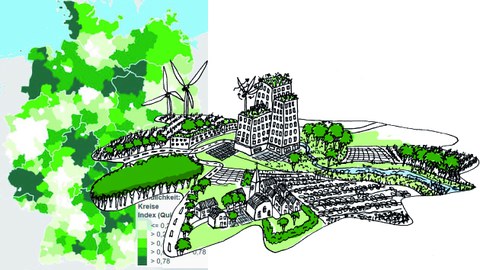City and country
Equivalent living conditions while shaping sustainable spatial relationships
Client:
Federal Environment Agency (UBA)
Duration:
07/2020 - 04/2024
Project team:
- TUD Dresden University of Technology (Prof. Dr. C. Schmidt)
- Space & Energy
- Prof. Hellriegel Institut e.V. at the Anhalt University of Applied Sciences (Prof. Dr.-Ing. M. Pietsch)
- plan + risk consult (Prof. Dr. Greiving & Partner)
- Helmholtz Centre for Environmental Research (Prof. Dr. W. Köck)
Project description:
The central objective of the project is to develop recommendations for the federal government, regions and local authorities on how spatial relationships between urban, peri-urban and rural areas can be made more sustainable, in particular more environmentally friendly, to define and operationalize environmental objectives to ensure equivalent living conditions and, last but not least, to ensure a broad public impact for the results of the project.
The creation of equivalent living conditions has been one of the most important objectives of spatial development policy since the 1970s. However, the question of equivalence has been discussed for just as long, with varying degrees of intensity and nuance. As firmly as the equivalence of living conditions is enshrined in law, it is still unclear, despite many scientific discussions, what equivalence actually means. A lack of environment-related indicators in the assessment of equivalent living conditions to date can also be observed in scientific studies on the subject. Environmental concerns have not yet been taken into account when determining the equivalence of living conditions.
This is precisely where "Stadt & Land" wants to start, because equivalence must also include people's quality of life, and this is closely linked to environmental quality. Against this background, it is long overdue that the indicator-based underpinning of the concept of equivalence also integrates environmental concerns. However, the operationalization of the concept is also associated with a number of challenges, which can be summarized in three points:
- Which environmental aspects are specifically suitable to function as targets for the equivalence of living conditions?
- Equivalence is rarely an unambiguous standard, which can be demonstrated by clear evidence. It is based on complex spatial constellations which, due to their difficult comparability, form a conglomerate that is difficult to understand. So what can actually be measured and is suitable as an indicator?
- The current discourse on the equivalence of living conditions is often ignited by disparities between urban and rural areas. But the distinction between urban and rural areas is increasingly blurred. Which indicators are equally suitable for urban and rural areas and are also able to reflect the currently perceived disparities?
Download brochure Urban and rural areas
Project team member:
 © Sven Ellger
© Sven Ellger
wissenschaftliche Mitarbeiterin
NameMs Mary Meier M. Sc.
Send encrypted email via the SecureMail portal (for TUD external users only).
